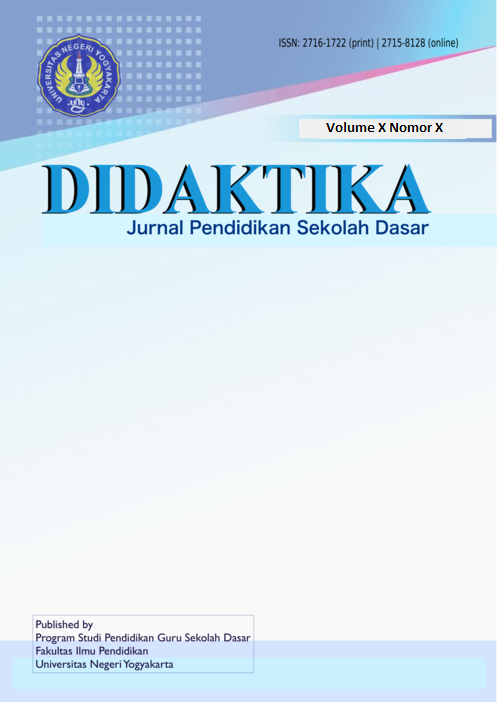Blended Learning as an Alternative Learning in Elementary Schools
DOI:
https://doi.org/10.21831/didaktika.v6i1.60592Abstract
References
Barton, R. (2004). Teaching secondary science with ICT. University Press.
Boohan, R. (2002). ICT and communication, in S. Amos and R. Boohan (eds). Aspects of teaching secondary science: Perspectives on practice,. Routledge Falmer.
Clyde, W. & Delohery, A. (2005). Using technology in teaching. Yale University Press.
Hadjerrouit, S. (2008). Towards a blended learning model for teaching and learning computer programming: A case study. Informatics in Education, 7(2), 181–210. https://doi.org/10.15388/infedu.2008.12
Hart, C. (1999). Doing a literature review: Releasing the social science research imagination (1st ed.). Sage Publications Ltd.
Hartley, D. E. (2001). Selling e-learning, American society for training and development, Implementing e-learning: getting the most from your e-learning investment. The ASTD International Conference. http://www.wired.com/news/business/0,1367,38504,00.html
Jarot. (2021). Peningkatan Motivasi Dan Hasil Belajar Ipa Dengan Model Pembelajaran Blended Learning Menggunakan Lms Google Classroom Pada Siswa Kelas Vi Sd Negeri Jeruk Soksok 1 Semester Ganjil Tahun Pelajaran 2020/2021. Jurnal Pendidikan Dan Pembelajaran, 2(1).
Khan, A. I., Qayyum, N., Shaik, M. S., Ali, A. M., & Bebi, C. V. (2012). Study of Blended Learning Process in Education Context. International Journal of Modern Education and Computer Science, 4(9), 23–29. https://doi.org/https://doi.org/10.5815/ijmecs.2012.09.03
Khusna Maziyatul, Sudaryanto, D. D. (2020). Penerapan Model Problem Based Learning (PBL) Berbasis Blended Learning untuk Meningkatkan Motivasi dan Hasil Belajar pada Siswa Kelas VI SD Muhammadiyah Banjaran. Prosiding PPG FKIP UAD.
Kusni, M. (2010). Implementasi sistem pembelajaran blended learning pada kuliah AE3121 getaran mekanik di Program Studi Aeronotika dan Astronotika. Seminar Nasional Tahunan Teknik Mesin (SNTTM) Ke-9, 13–15.
Lam, Y. W, et al. (2018). Improving argumentative writing: Effects of a blended learning approach and gamification. Language Learning & Technology, 22(1), 97–118. https://doi.org/https://dx.doi.org/10125/44583
Levac, D., Heather Colquhoun, K. K. O. (2010). Scoping studies: advancing the methodology. Implementation Science, 5, 69.
Musker, R. (2004). Using ICT in a secondary science department. dalam Barton, R. (eds.). In Teaching secondary science with ICT (p. 19). Open University Press.
Prescott, J. E., Bundschuh, K., Kazakoff, E. R., & Macaruso, P. (2018). Elementary school–wide implementation of a blended learning program for reading intervention. Journal of Educational Research, 111(4), 497–506. https://doi.org/https://doi.org/10.1080/00220671.2017.1302914
Rivera, J. H. (2017). The Blended Learning Environment: A Viable Alternative for Special Needs Students. Journal of Education and Training Studies, 5(2), 79. https://doi.org/https://doi.org/10.11114/jets.v5i2.2125
Sitorus, M. D. (2018). Pengaruh Model Blended Learning Dan Minat Belajar Terhadap Hasil Belajar Pkn Di Sekolah Dasar. Masters thesis, UNIMED.
Torraco, R. J. (2005). Writing Integrative Literature Reviews: Guidelines and Examples. Human Resource Development Review, 4(3), 356–367. https://doi.org/10.1177/1534484305278283
Ulfa, M. (2012). Interactive E-learning untuk Belajar Mandiri Anak. Jurnal Sarjana Institut Teknologi Bandung Bidang Teknik Elektro Dan Informatika, 1(1), 211–217.
Van Laar, E., van Deursen, A. J. A. M., van Dijk, J. A. G. M., & de Haan, J. (2017). The relation between 21st-century skills and digital skills: A systematic literature review. Computers in Human Behavior., 72, 577–588. https://doi.org/https://doi.org/10.1016/j.chb.2017.03.010
Welington, J. (2004). Multimedia in science teaching, dalam Barton, R. (eds.),. In Teaching secondary science with ICT (p. 96). Open University Press.
Downloads
Published
How to Cite
Issue
Section
Citation Check
License
- Authors retain copyright and grant the journal right of first publication with the work simultaneously licensed under a Creative Commons Attribution License that allows others to share the work with an acknowledgement of the work's authorship and initial publication in this journal.
- Authors are able to enter into separate, additional contractual arrangements for the non-exclusive distribution of the journal's published version of the work (e.g., post it to an institutional repository or publish it in a book), with an acknowledgement of its initial publication in this journal.
- Authors are permitted and encouraged to post their work online (e.g., in institutional repositories or on their website) prior to and during the submission process, as it can lead to productive exchanges, as well as earlier and greater citation of published work.






